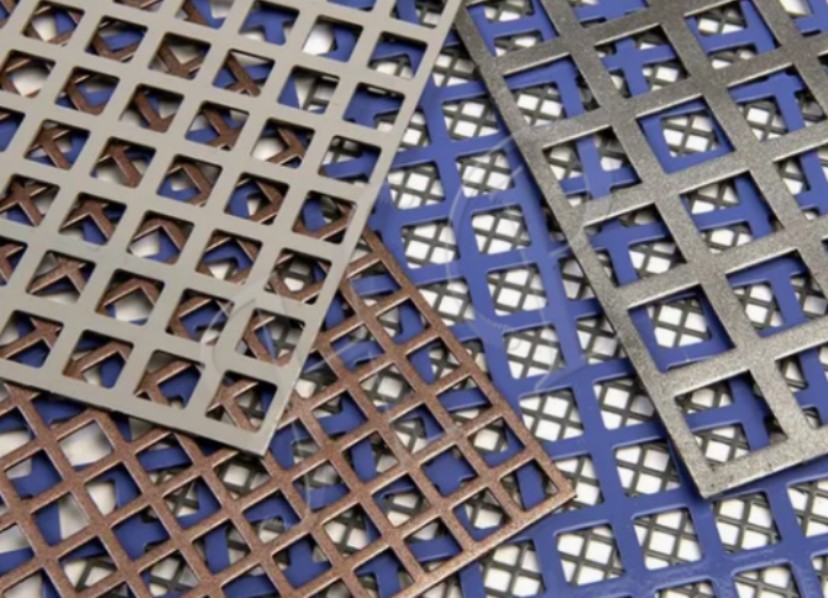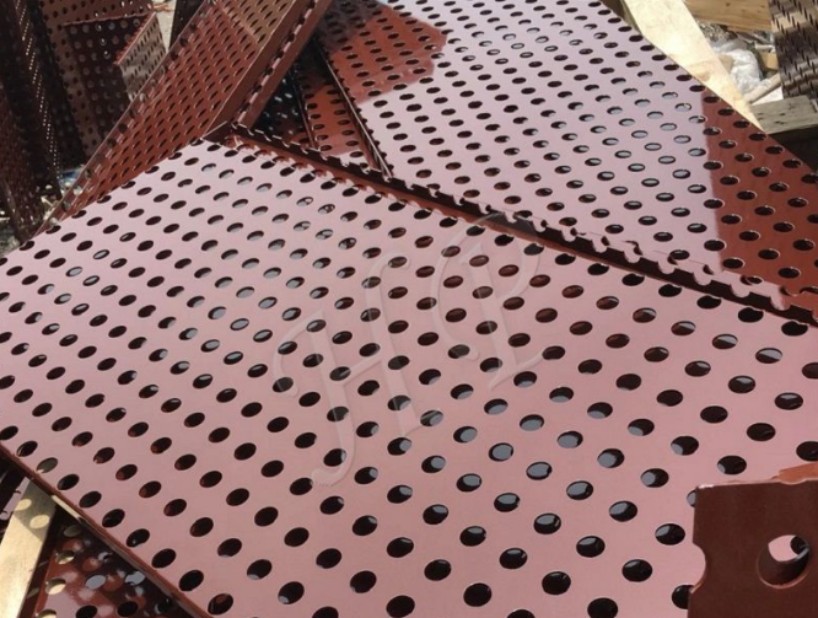Let’s be honest. For most of us, when we think about construction materials, our minds don’t exactly leap to words like “breathtaking” or “elegant.” We think of concrete—brutal, gray, and unyielding. We think of lumber, practical and familiar. We think of rebar, the hidden skeleton. These are the workhorses, the unsung heroes that hold our world together, but they rarely ask for, or receive, a second glance. They are purely about function, about brute strength. But what if I told you there’s a material that has been hiding in plain sight, a chameleon in the industrial world, that is quietly blurring the lines between the backbone of a building and its star performer? This isn’t some new, space-age polymer or a hyper-engineered composite. It’s something far more straightforward, yet infinitely more clever. We’re talking about Stainless Steel Expanded Metal.
Imagine taking a solid, robust sheet of stainless steel and performing a kind of architectural alchemy on it. No cutting away material and discarding it, no melting and reforming. Instead, it’s slit and stretched, transformed in a single, continuous process. This act of expansion creates a unified web of diamond-shaped patterns, a mesh that is both ethereal and incredibly strong. It’s this very process that gives Stainless Steel Expanded Metal its unique personality—it’s lighter than a solid sheet, it allows air and light to pass through, and it gains a rigidity that defies its apparent openness. And it’s this unique set of properties that architects and designers are now wielding to create spaces that are as smart as they are stunning.
The Unshakeable Functionality of the Material
Now, before we get swept away by its good looks, we have to pay respects to the raw, utilitarian prowess of this stuff. At its core, Stainless Steel Expanded Metal is a workhorse. Its functionality is baked into its very DNA, starting with that incredible strength-to-weight ratio. Because it’s a single, continuous piece of metal that has been stretched, not assembled, it doesn’t have weak points like welds or joints. This makes it phenomenally strong. You can walk on it, drive on it, and use it to shield heavy machinery, all while using less material than a solid plate. This inherent strength makes it the go-to choice for walkways, ramps, and safety fencing in industrial settings where falling debris or slippery surfaces are a concern. The open mesh allows liquids, dirt, and snow to pass right through, eliminating puddles and reducing the risk of accidents. It’s a simple, brilliant solution that you’ll find in factories, on oil rigs, and on construction sites around the globe.
But the practical benefits don’t stop at your feet. Let’s talk about ventilation. In any building or enclosure that houses equipment, electronics, or even just stuffy air, heat buildup is a constant enemy. A solid wall traps heat, while a fully open one compromises security and protection. Stainless Steel Expanded Metal strikes the perfect balance. It acts as a superb physical barrier, keeping people and large objects out, while simultaneously allowing air to circulate freely. This passive ventilation is a godsend for electrical cabinets, machine guards, and warehouse partitions. It prevents overheating, reduces moisture buildup, and just makes for a healthier, more functional environment. It’s a see-through wall that breathes, a concept that is as practical as it is difficult to achieve with any other single material.
And then there’s the element of durability. We’re dealing with stainless steel here, which means it comes with a built-in superpower: corrosion resistance. This isn’t your average sheet metal that will start to blush with rust at the first sign of rain. The chromium in the steel forms an invisible, protective layer that fights off the elements. Whether it’s the relentless salt spray of a coastal city, the chemical-laden air of an industrial zone, or just the constant beat-down of sun and rain, Stainless Steel Expanded Metal stands firm. This longevity is a huge part of its functional appeal. It doesn’t need constant painting or babysitting. You install it, and it pretty much takes care of itself for decades, making it a incredibly cost-effective choice over the long haul. It’s the low-maintenance, high-performance employee every project manager dreams of.
When Form Meets Function The Aesthetic Leap
So, we’ve established that Stainless Steel Expanded Metal is a functional powerhouse. But this is where the story gets really interesting. At some point, a visionary architect looked at a piece of industrial grating and didn’t just see a safety feature or a ventilation panel. They saw pattern. They saw rhythm. They saw a way to play with light and shadow in a way that solid materials never could. This was the moment the material crossed over from the machine shop to the art gallery, from the factory floor to the facades of the world’s most stunning buildings.

The primary aesthetic tool in its arsenal is its ability to create dynamic screens. Think of it as a veil for a building. Instead of a blank, imposing wall, a facade made from Stainless Steel Expanded Metal can be both transparent and opaque, depending on your viewpoint and the time of day. From a distance, it might appear as a solid, shimmering surface. As you move closer, the details of the diamond pattern emerge, and you start to catch glimpses of what’s behind it. This creates a sense of mystery and depth, inviting engagement. During the day, the sun casts ever-changing patterns of light and shadow through the mesh onto the interior floors and walls. At night, when the interior lights are on, the building glows from within, with the Stainless Steel Expanded Metal facade acting like a giant, textured lantern. This transformative quality makes the building feel alive, changing its character from morning to night.
The texture and pattern itself are a designer’s dream. The standard diamond pattern is iconic, offering a rhythmic, almost pixelated feel that can bring a modernist, geometric order to a structure. But the possibilities don’t end there. The material can be expanded into an incredible array of patterns—floral, hexagonal, decorative—to suit any architectural style. Furthermore, the surface finish can be manipulated to achieve different visual effects. A standard mill finish has a utilitarian, slightly reflective look. But it can be brushed to a soft, satin sheen, or even polished to a mirror-like reflectivity that dazzles in the sunlight. For a truly bold statement, Stainless Steel Expanded Metal can be powder-coated in virtually any color you can imagine. Imagine a vibrant red mesh screen on a university building, or a sleek, blackened steel facade on a high-end corporate headquarters. The aesthetic versatility is truly staggering.
This isn’t just about making things look pretty, either. This is where form and function have a brilliant marriage. A sunshade made from Stainless Steel Expanded Metal is a perfect example. In hot climates, direct sunlight can turn a glass-walled building into an oven, skyrocketing air conditioning costs. A screen of Stainless Steel Expanded Metal mounted just off the facade acts as a brise-soleil, blocking the harshest rays of the sun while still allowing diffused light to enter and views to exit. It reduces solar heat gain, saving energy, all while giving the building a distinctive, layered identity. It’s a beautiful solution to a very practical problem. Similarly, when used as balcony railings or interior stairwell enclosures, it provides safety and security without the closed-in, claustrophobic feeling of a solid wall, maintaining sightlines and a sense of openness. The material is literally shaping the way we experience space.
Weaving the Mesh Into Real World Spaces
It’s one thing to talk theory, but the true magic of Stainless Steel Expanded Metal reveals itself in real-world applications. Let’s take a virtual tour of some of the places where this material is making a difference. Start with a modern public library. The architect needed a way to shield the reading room from the harsh afternoon sun but didn’t want to plunge the space into darkness. The solution? A vast, curtain-like facade of Stainless Steel Expanded Metal. From the street, the building has a dignified, metallic presence. Inside, readers are treated to a soft, dappled light, with the patterns of the mesh casting ever-shifting abstract shapes across the tables and floors. It’s a serene, almost poetic environment crafted by a fundamentally industrial product.
Now, walk into a trendy new restaurant or boutique hotel. Look up. You might see ceiling panels made from Stainless Steel Expanded Metal, hiding unsightly pipes and ductwork while allowing air to circulate from the HVAC system above. Look down the grand staircase, and the balustrade might be the same material, providing safety without obstructing the view of the stunning architectural details. In the bathroom, you might find decorative tiles made from small, finely crafted pieces of Stainless Steel Expanded Metal, adding a touch of industrial chic. Here, the material is used as an interior design accent, its metallic sheen and texture contrasting beautifully with warm woods, raw concrete, and plush fabrics.
But its use isn’t confined to the rarefied air of high-design. Go to a city park, and you might find it used as cladding for a public restroom or a maintenance shed. This is a brilliantly pragmatic choice. Its durability means it can withstand vandalism and the elements far better than wood or painted surfaces. Its open nature discourages the accumulation of trash and provides natural ventilation, making it a more hygienic and low-odor solution. In these everyday contexts, Stainless Steel Expanded Metal performs a quiet, humble duty, proving that good design and smart material choices can and should be accessible to everyone, not just luxury developments. It brings a touch of elegance and permanence to the most utilitarian of public structures, improving our shared environment in subtle but meaningful ways.
So, the next time you’re walking through a city, take a closer look. Peer past the obvious glass and concrete. You might just start to notice it everywhere—the shimmering screen on the side of a new office tower, the sturdy yet graceful railing on a pedestrian bridge, the decorative panel in a shopfront. Stainless Steel Expanded Metal is no longer just a background player. It has emerged as a material that speaks the language of both the engineer and the artist. It tells us that strength doesn’t have to be brutish, that safety doesn’t have to be cage-like, and that beauty in the built environment can be found in the most unexpected of places. It is, in every sense, a material for our time—versatile, resilient, and intelligently beautiful.
You may also like
-
The Heart of Philanthropy: Andi Sklar’s Mission for Change
-
Advanced Digital Marketing Courses in Pune for Digital Marketing Managers
-
Bitcoin Price and the Rise of Stablecoins
-
Industrial Clutches: The Role of Pneumatic and Hydraulic Systems
-
The Benefits of Engaging a LinkedIn Advertising Agency for Effective Campaign Management

